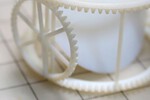Instructables Build Process CAD model Github
RELATED:
 GIMBAL
GIMBAL
 LOCKED LETTERS
LOCKED LETTERS
 MECHANICAL WALKING MACHINE
MECHANICAL WALKING MACHINE
 ORIGAMI SIMULATOR
ORIGAMI SIMULATOR
 SHELL FORM FINDING
SHELL FORM FINDING
An orrery is a clockwork mechanism depicting the motions of celestial bodies. This particular orrery is a type of "tellurion" because it features the Earth, Moon, and Sun. I've designed it to accurately predict the date of future eclipses and differentiate between annular and total eclipses. Nearly all the parts were fabricated from brass on a CNC machine (using some very tiny cutting tools). The base is made from a piece of cherry that I cut and glued into a book-matched pattern. Full build documentation, CAD files, and CNC toolpathing available on Instructables. Additional resources on Github.
My main intention with this design was to accurately depict the relative motions of the Earth, Moon, and Sun with a focus on accurately modeling eclipses. The arm of the orrery swings around once per year as indicated by a large calendar dial. This motion drives five separate gear trains that depict various things:
- The Moon revolves around the Earth and is tidally locked to the Earth (only a single side of the Moon is visible from Earth).
- The tilt of the Earth points toward a fixed point in space (the north star) as it revolves around the Sun.
- The Moon glides along a cam, giving it a slightly tilted orbit. Eclipses only occur at two locations (the "nodes") along this tilted orbit when it crosses the plane of the Earth's rotation around the Sun (the ecliptic plane). The orientation of the tilt slowly precesses (rotates) over time.
- An arrow indicates the position of the Moon's closest approach to Earth, allowing you to differentiate between annular and total eclipses. This also precesses slowly over time.
- A century dial marks off 100 years.
I decided not to include the rotation of the Earth in this design because it rotates so quickly compared to the other motions that it would accumulate too much error to be meaningful.
Nearly 1000 saves of the 3D model while designing my orrery (2017-2021). Most features in the CAD model originate from a single sketch located at the very beginning of the design history; any changes made to this sketch will propagate out to the rest of the design.

I machined (nearly) all the parts for this project, but I aimed to keep the amount of separate processes down and use off the shelf components where possible. Most parts were made in a 3-axis machining process and a few others were made on the lathe.
I started designing the orrery shortly after the "Great American Eclipse" of 2017. I had a chance to see the eclipse in the "path of totality" somewhere outside St. Louis – it was the first total eclipse I'd ever seen. Total eclipses occur when the Moon moves exactly between the Earth and Sun. By chance, the Moon (a close, but very tiny object) and the Sun (a distant, but very large object) are approximately the same size in the sky to observers on Earth. Because of this, the Moon is big enough to block out all direct sunlight, but small enough to give us a glimpse of the hot gasses that make up the sun's atmosphere – the corona. The contrast between the black center of the eclipse and the wispy corona around its edges are part of what make total eclipses so awe-inspiring.
What fascinates me about total eclipses is how lucky we are to be able to observe them at this moment in Earth's history. The distance between the Earth and the Moon is gradually increasing each year, meaning the apparent size of the Moon in the sky is shrinking over time. In fact, if we went back billions of years the Moon would appear so large in the sky it would block out the corona, and a billion years from now there will be no more total eclipses. Even now we are balancing on a knife's edge, the slight shift in the distance of the Moon from the Earth caused by its elliptical orbit is enough to produce "annular" eclipses – where the Moon does not completely block out the Sun and a ring of direct light is still able to reach Earth.


A single silver tooth marks a special day.

The orrery design consists of 4 interconnected gear trains that control the relative motions of the earth, moon, and sun, and a fifth gear train that ticks forward a dial marking 100 years. I wrote several scripts to calculate a set of optimal gear ratios for each of the five gear paths in my mechanism. The final gear ratios were selected by hand, balancing aesthetics, complexity of design/manufacturing, and accuracy. One of the main constraints was that all of the gears should line up coaxially on five axles in the design. I chose gear ratios that minimized the angular error in each gear train to less than 1.5 degrees after the mechanism has been rotated around the sun 100 times. I also optimized for gear diameters that minimized the amount of scaling I had to do to the gear teeth to get everything to fit.
Final 3D model and parts laid out flat for manufacturing.
Machining gears from 1/8" and 3/16" brass stock on a CNC mill. Smallest diameter endmill used = 1/32".






